1892 – Born on July 20, Elmer Joseph Ritter resides in family home and bakery at 1218 E. Oak Street, New Albany, Indiana, and attended St. Mary’s Catholic Grade School
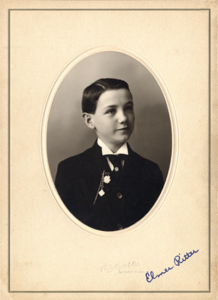 1906 – Began studies at St. Meinrad Seminary on September 12.
1906 – Began studies at St. Meinrad Seminary on September 12.
1917 – Ordained a priest on May 30. Celebrated first Mass at St. Mary of the Annunciation Catholic Church, his home parish in New Albany, Indiana, on May 31.
1917 – Assigned on July 7 to St. Patrick’s Church in Indianapolis as Curate. On October 12 assigned to Saints Peter and Paul Cathedral as assistant to Bishop Chartrand.
1925 – Became Assistant Rector on August 25. Raised funds to build Cathedral High School. Administered The Indiana Catholic and Record (now The Criterion).
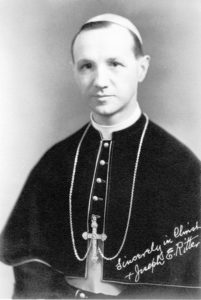 1933 – Appointed auxiliary bishop of the Diocese of Indianapolis on March 28, and took his baptismal name Joseph.
1933 – Appointed auxiliary bishop of the Diocese of Indianapolis on March 28, and took his baptismal name Joseph.
1934 – Installed as Bishop of Indianapolis (youngest in America) on March 24.
1937 – Ordered the school integration of three academies for girls in the diocese.
1938 – Faced with protests by the Ku Klux Klan including cross-burning in front of Cathedral rectory in opposition to racial integration.
1939 – Ordered a grade school in Beech Grove to admit black children.
1942 – Ordered integration of the Catholic schools in Evansville. Instructed all students to wear uniforms to avoid economic distinctions.
1943 – Integrated all schools within the Catholic Dioceses of Indianapolis.
1944 – Installed as first archbishop (youngest in America) when Indianapolis was elevated to an Archdiocese on December 19.
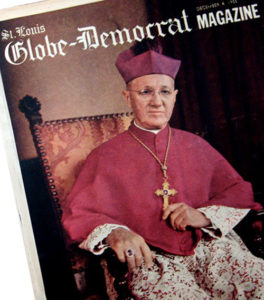 1946 – Installed as archbishop of St. Louis on October 8.
1946 – Installed as archbishop of St. Louis on October 8.
1947 – Allowed students from St. Joseph High School for black students to join students from all other high schools at graduation ceremonies held in the St. Louis Cathedral. Instructed all pastors in St. Louis to end segregation, resulting in numerous Catholic student transfers to segregated public schools.
1947 – Wrote letter on September 21, recommending excommunication for Catholics who do not obey the decree for inclusion of all students.
1949 – Began seven-year fundraising effort to construct a children’s hospital in memory of his predecessor, Cardinal John Glennon.
1950 – Pioneered for students with disabilities. Appointed a Director of Special Education and assistant to parish schools. Provided 31 classrooms for students with disabilities. Created two group homes – a residential center and a vocational center – the first diocese-wide educational opportunity for students with disabilities. Advocated for the National Catholic Education Center to establish a special education department in Washington D.C.
1952 – Assisted immigrants resettling to the U.S. after World War II and from Cuba.
1955 – Recommended the Catholic Hospital Association to end discrimination.
1956 – Purchased and converted old DeSoto Hotel to the Hotel Alverne as a home for elderly men and women of low socio-economic means.
1956 – Sent diocesan priests to La Paz Bolivia as missionaries.
1960 – Notified by personal letter on December 14 from Pope John XXIII of his impending elevation to the College of Cardinals.
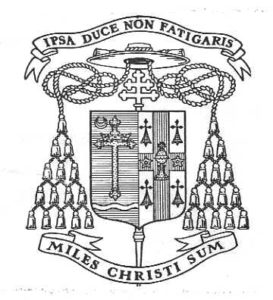
1961 – Bestowed the Red Hat on January 18. First American given the honor of thanking the Pope as speaker of the group.
1961 – On April 30. honored by family, friends, and Knights of Columbus at a special Mass and reception celebrating elevation to the College of Cardinals, at St. Mary’s Catholic Church in New Albany, IN.
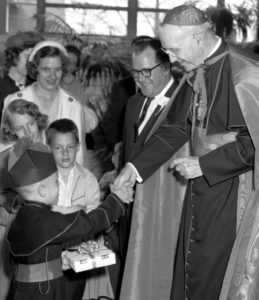
1963 – Led a Pastoral Institute on Human Rights.
1963 – Attended Vatican Council II: Session Two on November 18. Advocated for religious liberty, ecumenism, and the use of English in liturgy. First to speak on the topic in Rome, but had already discussed with American bishops and represented their voice and his own.
1964 – Formed the Archdiocesan Commission on Ecumenism on March 19.
1964 – Celebrated first public Mass in English on August 25 in Kiel Auditorium in St. Louis.
1964 – Attended Vatican Council II: Session Three on September 14. Advocated for a relationship with the Jewish people; for ecumenism and religious liberty; for broad acceptance and recognition of lay people; for missionary work; for Catholic education to include scientific inquiry and students of all religions; and for mixed marriages of religions.
1964 – Spoke at a major session of the Episcopalian Convention in October.
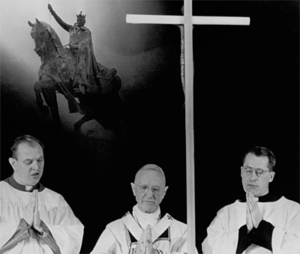 1964 – Introduced Mass in English in the USA on November 29, the first Sunday of Advent.
1964 – Introduced Mass in English in the USA on November 29, the first Sunday of Advent.
1965 – Sent three sermons on ecumenism to be preached in each parish. Wrote article for World Council of Churches on ecumenism.
1965 – Gave commencement address at Eden Seminary entitled “The Seminary in an Ecumenical Age.” Stood strong against negative backlash and encouraged others to speak on behalf of fostering an ecumenical spirit.
1965 – Attended Vatican Council II: Session Four on September 14. Two days later, spoke for the final time in support of religious liberty.
1965 – The Declaration on Religious Liberty was accepted on September 22 and confirmed by the Pope and bishops on December 7 as one of sixteen documents of Vatican Council II. The document declared Religious Freedom a right of mankind.
1967 – Celebration on June 1 to honor his 50th Ordination Anniversary with friends from St. Mary Parish and St. Meinrad.
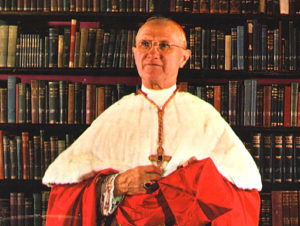 1967 – Died on June 10 following heart attack suffered June 5.
1967 – Died on June 10 following heart attack suffered June 5.
1967 – At his request, Low Funeral Mass on June 15 followed by burial in the Calvary Cemetery priests’ lot in St. Louis. Attendees included 4 cardinals, 3 cardinal designates, 10 archbishops, 48 bishops and 3 abbots; also more than 50 Protestant, Jewish and Orthodox leaders.
1994 – Re-interred in the Cathedral Basilica of St. Louis on Nov. 2.
